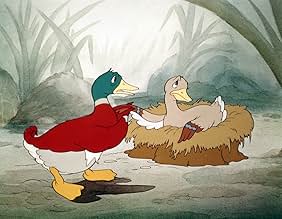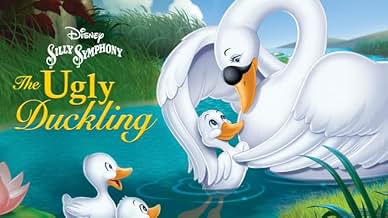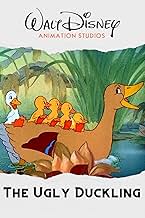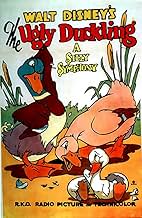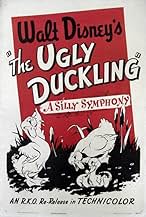Ajouter une intrigue dans votre langueA baby duckling is shunned by his family because he is different. He is also rejected by all of the other birds and animals. Finally a mother swan adopts him as one of her brood.A baby duckling is shunned by his family because he is different. He is also rejected by all of the other birds and animals. Finally a mother swan adopts him as one of her brood.A baby duckling is shunned by his family because he is different. He is also rejected by all of the other birds and animals. Finally a mother swan adopts him as one of her brood.
- Réalisation
- Scénario
- Casting principal
- Récompensé par 1 Oscar
- 1 victoire au total
Amanda Cewel
- Mother Duck (speaking)
- (non crédité)
Tom Cotry
- Father Duck (speaking)
- (non crédité)
Avis à la une
A great short animation offering to Hans Christian Andersen text new touches, significances and nuances.
A remake , seductive for colors but especially for the echo in contemporary crisis , from social exclusion to need of love and the apparences, selfishness, migrants and the truth more significant than the misery of previews details.
So, I saw it after good decades and I saw it from different perspective , first in context of its time, then in the context of our time , dizzy , confuse and looking for sense.
So, easy to define it as loving and just precious. So, the ugly duckling and the steps to find its happiness.
A remake , seductive for colors but especially for the echo in contemporary crisis , from social exclusion to need of love and the apparences, selfishness, migrants and the truth more significant than the misery of previews details.
So, I saw it after good decades and I saw it from different perspective , first in context of its time, then in the context of our time , dizzy , confuse and looking for sense.
So, easy to define it as loving and just precious. So, the ugly duckling and the steps to find its happiness.
The last of the "Silly Symphonies","The Ugly Duckling" demonstrates the heights that Walt Disney and his artists had reached by the late 1930s and early 1940s. In just eight or nine minutes, and without a word of dialogue, we are presented with Hans Andersen's wistful fairy-tale. Exquisite drawings by animators including Milt Kahl and Eric Larson (both of whom would provide major contributions to the feature-length "Bambi")and lush watercolour layouts by David Hilberman combine with elegant camera movement and a lilting score by Albert Hay Malotte to create a miniature jewel of animation. The scene where the little duckling plays affectionately with the wooden decoy duck because it is the only thing in the world not to reject it, is one of the saddest in all cinema. The great Warner Bros animator Chuck Jones acclaimed "The Ugly Duckling" as one of the greatest short subjects ever made - and indeed, it is.
The only reason I give this film a 9 and not a 10 is that it's actually a remake of a film this same studio made eight years earlier. I tend to be a little tougher on remakes plus it just doesn't take nearly as much effort to remake a film instead of do one from scratch. However, despite this concern, I can see why this film received the Oscar for Best Animated Short. It is simply wonderful from start to finish.
First, the animation is exactly what you'd expect from Disney from this era. In the 1930s, no other studio came close in quality of animation and music. The whole package was simply terrific and could not be beat. I particularly loved the wonderful backgrounds as well as the great use of colors--nicely muted and soft.
Second, the story, while very familiar to most, is wonderful. I am not ashamed to admit that by the end of the film, my eyes were very misty--it is a lovely and sentimental film. A joy to watch from start to finish.
First, the animation is exactly what you'd expect from Disney from this era. In the 1930s, no other studio came close in quality of animation and music. The whole package was simply terrific and could not be beat. I particularly loved the wonderful backgrounds as well as the great use of colors--nicely muted and soft.
Second, the story, while very familiar to most, is wonderful. I am not ashamed to admit that by the end of the film, my eyes were very misty--it is a lovely and sentimental film. A joy to watch from start to finish.
There is something really quite touching about this Disneyfication of the timeless Hans Christian Andersen story. We start with the expectant parents awaiting their fifth chick. It's born but clearly isn't the same as the others and it's promptly rejected. Abandoned to fend for itself, it tries to make friends but everything is new and unfamiliar. Then, fortune smiles and ... Andersen's fables always did have a valid moral underpinning them and this one seems all the more ripe for a sensitively scored and delicately drawn version that has, mercifully, been spared the traditional singing accompaniment. It's surprisingly effective, this.
For ten years, Walt Disney's talented animators pumped out cartoon after cartoon for his 'Silly Symphonies.' Walt decided it was time to shut down one of animation's most successful series. The final film of the 'Silly Symphonies' was April 1939's "The Ugly Duckling." The series went out with a bang, with the duck short winning the Academy Award for Best Short Subject (Cartoon), the 'Silly Symphonies' eighth Oscar win. The 75-cartoon series proved to be an invaluable testing ground for Disney to create and test new techniques and technologies, resulting in Walt's first feature film, 1938's "Snow White and the Seven Dwarfs."
Disney's animators, led by Jack Cutting and Ham Luske, had completed Hans Christian Andersen's fairy tale cartoon the year before. But Walt elected to hold off its release until he secured a Radio City Music Hall premier during the Easter Week which happened to front-end Fred Astaire and Ginger Rogers' "The Story of Vernon and Irene Castle." The 1939 version of "The Ugly Duckling" was his second telling of the 1843 Andersen story about a newly hatched white duckling who clearly didn't belong to the brood of baby mallard ducks the mother had just delivered. The most recent version was much sadder than its 1931 black-and-white predecessor, which played up the humorous aspects of the tale. But the Oscar-winning 1939 cartoon's ending was more in line with the written Andersen work than the earlier one.
"The Ugly Duckling" of 1939 concluded the 'Silly Symphonies'' storied series beginning in 1929 with "The Skeleton Dance." The string of successive cartoons was intended to be a platform for mainly musically-based animations with very little yapping. Over the course of its ten-year lifespan, the symphonies introduced a variety of innovations in animation, including the first three-strip Technicolor cartoon in 1932's "Flowers and Trees," special effects, more realistic human and animal movements, the multi-plane camera, and on and on. Only the cartoon series 'Tom and Jerry' would achieve the number of Academy Award wins as the 'Silly Symphonies.' After the overwhelming success of "Snow White," Walt decided to concentrate on his ambitious full-length films and his Mickey Mouse shorts. Some say the spirit of the series was carried on by his all-musical animated feature film, 1941's "Fantasia."
Disney's animators, led by Jack Cutting and Ham Luske, had completed Hans Christian Andersen's fairy tale cartoon the year before. But Walt elected to hold off its release until he secured a Radio City Music Hall premier during the Easter Week which happened to front-end Fred Astaire and Ginger Rogers' "The Story of Vernon and Irene Castle." The 1939 version of "The Ugly Duckling" was his second telling of the 1843 Andersen story about a newly hatched white duckling who clearly didn't belong to the brood of baby mallard ducks the mother had just delivered. The most recent version was much sadder than its 1931 black-and-white predecessor, which played up the humorous aspects of the tale. But the Oscar-winning 1939 cartoon's ending was more in line with the written Andersen work than the earlier one.
"The Ugly Duckling" of 1939 concluded the 'Silly Symphonies'' storied series beginning in 1929 with "The Skeleton Dance." The string of successive cartoons was intended to be a platform for mainly musically-based animations with very little yapping. Over the course of its ten-year lifespan, the symphonies introduced a variety of innovations in animation, including the first three-strip Technicolor cartoon in 1932's "Flowers and Trees," special effects, more realistic human and animal movements, the multi-plane camera, and on and on. Only the cartoon series 'Tom and Jerry' would achieve the number of Academy Award wins as the 'Silly Symphonies.' After the overwhelming success of "Snow White," Walt decided to concentrate on his ambitious full-length films and his Mickey Mouse shorts. Some say the spirit of the series was carried on by his all-musical animated feature film, 1941's "Fantasia."
Le saviez-vous
- AnecdotesThe last Silly Symphony cartoon. Also, the only one to be a remake (of Le vilain petit canard (1931)).
- GaffesWhen the hero is reunited with his family, we discover that he is one of five baby swans. However, for a brief moment, six baby swans appear on screen as they swim around one another before returning to their mother.
- ConnexionsEdited into Walt Disney Cartoon Classics Volume 5: Disney's Best of 1931-1948 (1983)
- Bandes originalesBorn to Ugly Duckling
(uncredited)
Traditional
Performed by studio orchestra
Meilleurs choix
Connectez-vous pour évaluer et suivre la liste de favoris afin de recevoir des recommandations personnalisées
Détails
- Date de sortie
- Pays d’origine
- Site officiel
- Langue
- Aussi connu sous le nom de
- Le pauvre petit abandonné
- Sociétés de production
- Voir plus de crédits d'entreprise sur IMDbPro
- Durée
- 9min
- Rapport de forme
- 1.37 : 1
Contribuer à cette page
Suggérer une modification ou ajouter du contenu manquant

